[Reposting the whole thing because of so many glorious photos… Thanks to Cartier for giving me a link in a comment to a Reddit post that had this source… with more photos.]
Before the war Argentina hosted a strong, very-well-organized pro-Nazi element that was controlled by the German ambassador. In the spring of 1938, some 20,000 Nazi supporters attended a “Day of Unity” rally held at the Luna Park stadium in Buenos Aires to celebrate the Anschluss, the annexation of Austria into the Third Reich.
U.S. Vice-Consul W. F. Busser attended the rally along with 20,000 others. Busser – it is unclear how much German he understood – reported that Luna Park did had all the trappings of the Berlin Sportpalast rallies: massed choruses of “Deutschland über Alles” and the party anthem “Horst-Wessel Lied”, the full panoply of Nazi organizations – Hitler Youth, Frontline Veterans, the SA – with their tossing standards, a high podium backed by Ein Volk, ein Reich, ein Führer blazoned in giant Gothic letters on an enormous blood-red backdrop.
Argentine fascist youth – the Alianza de Juventud Nacionalista – were conspicuous in their gray shirts and Sam Browne belts; Nazi storm troopers ringed the entire auditorium. The latter were generally, Busser reported, of two types: “thick-necked and square-headed with well-filled paunches, or thin, pasty-faced, but terribly earnest…they must have been mostly waiters or poorly paid clerks”. The local eminences orated: Chargé d’Affaires Erich Otto Meynen (ambassador Thermann was in Germany); Richard Staudt, an immensely wealthy German-Argentine businessman who had been Austrian consul since 1932 (Staudt, never one to allow self-interest to be deflected by principle, later distanced himself from the Third Reich); and the ubiquitous Dr. Ott – a political speaker (Reichsredner) sent out by the Third Reich , who “gave an almost perfect imitation of Hitler”. “The speeches were exercises in mass hypnosis”, Busser said.
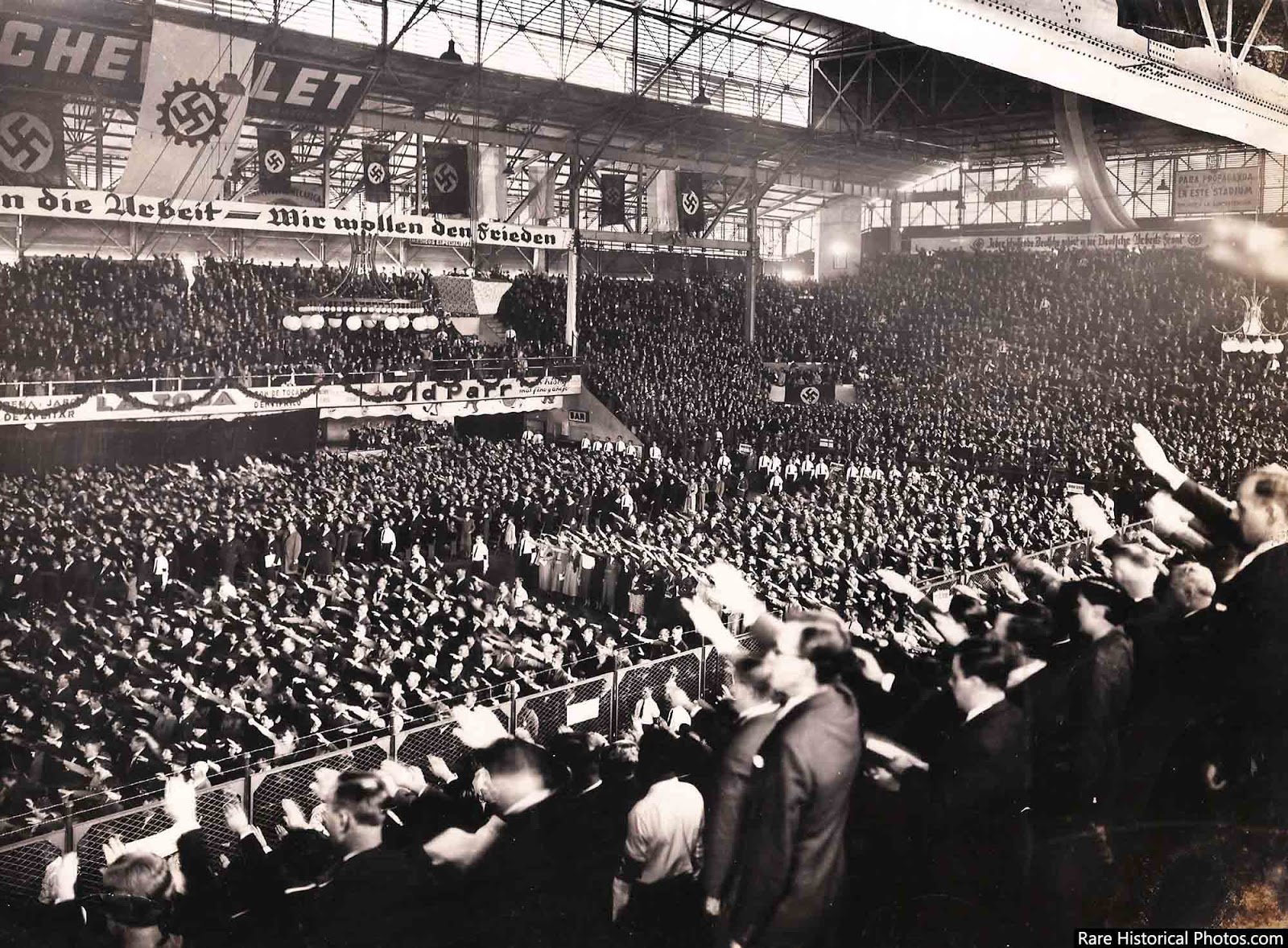
In the spring of 1938, some 20,000 Nazi supporters attended a “Day of Unity” rally held at the Luna Park stadium in Buenos Aires to celebrate the Anschluss.

Before the war Argentina hosted a strong, very-well-organized pro-Nazi element that was controlled by the German ambassador.
Outside Luna Park, there was disorder and bloodshed. Although forbidden to do so, the Federacion Universitaria Argentina (FUA) and socialist youth groups held a counter demonstration in nearby Plaza San Martín; the demonstration spilled over into adjacent streets; German flags were burned; German banks and the Instituto Cultural Germano-Argentino were stoned. Two elderly bystanders uninvolved in the demonstration were trampled to death by police horses. A few days later, Manuel Alvarado, interim chancellor of the Foreign Ministry, apologized publicly to Chargé d’Affaires, deploring a “certain press” offensive to German nationality that failed to “take into account the cordial relations between the two nations”.
The swastika in a gear seen in some of the flags is the badge of the German Labour Front (Deutsche Arbeitsfront, DAF), the National Socialist trade union organization which replaced the various trade unions of the Weimar Republic after Adolf Hitler’s rise to power. The banners read: “Wir wollen den Frieden” (We want the Peace); “Jeder arbeitende Deutsche gehört in die Deutsche Arbeiterfront” (Every working German belongs in the German labour front). Also there is a Chevrolet banner hidden behind the DAF flag, probably just a fixed feature of the venue.
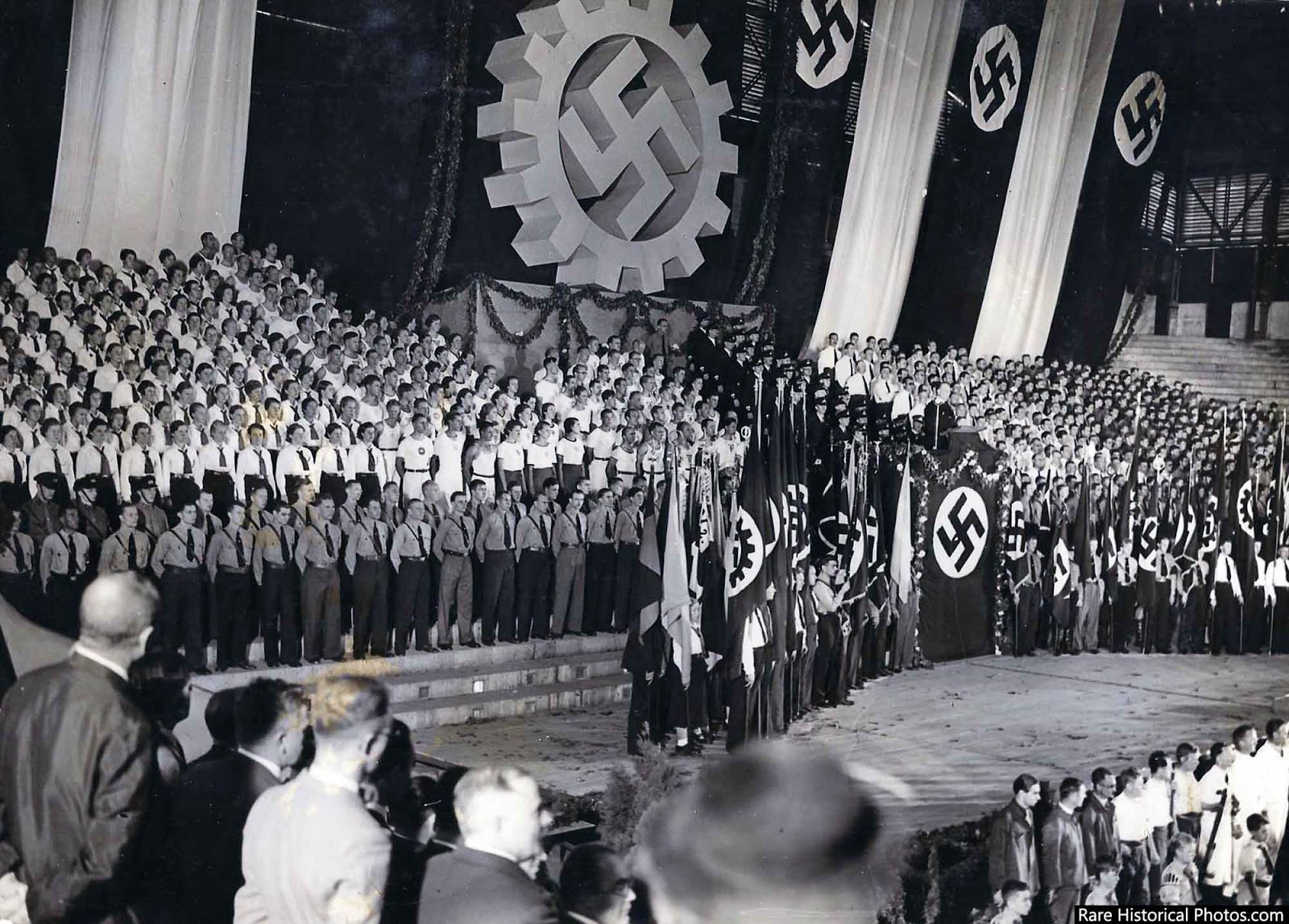
Argentine fascist youth – the Alianza de Juventud Nacionalista – were conspicuous in their gray shirts and Sam Browne belts.
Interesting facts:
- Due to the hundreds of thousands of German immigrants who lived in the country, Argentina maintained close ties with Germany and remained neutral for much of World War II. In the years after the end of the war, Argentine President Juan Peron secretly ordered diplomats and intelligence officers to establish escape routes, so-called “ratlines”, through ports in Spain and Italy to smuggle thousands of former SS officers and Nazi party members out of Europe. Some of them lived in Argentina under their real names, but others clandestinely obtained new identities. Some well-known Nazis that emigrated to Argentina are Adolf Eichmann, Josef Mengele, Aribert Heim, Erich Priebke, Eduard Roschmann and “Bubi” Ludolf von Alvensleben.
- As with numerous other fascist-leaning South American leaders, Juan Peron had been drawn to the ideologies of Benito Mussolini and Adolf Hitler while serving as a military attaché in Italy during the early years of World War II. The Argentine president also sought to recruit those Nazis with particular military and technical expertise that he believed could help his country, much like the United States and the Soviet Union who both poached scientists from the Third Reich to assist them in the Cold War.
(Photo credit: “Luna Park. World-renowned stage. Published in 1999” / The Nazi Menace in Argentina, 1931-1947).
[Final note: Yes, I know that the source went «evuul NaZZis» mode. Nonetheless, the photos are in very good quality, consider that these are almost eighty years old…]
Also, I ought to link to the source as well. They come from here.

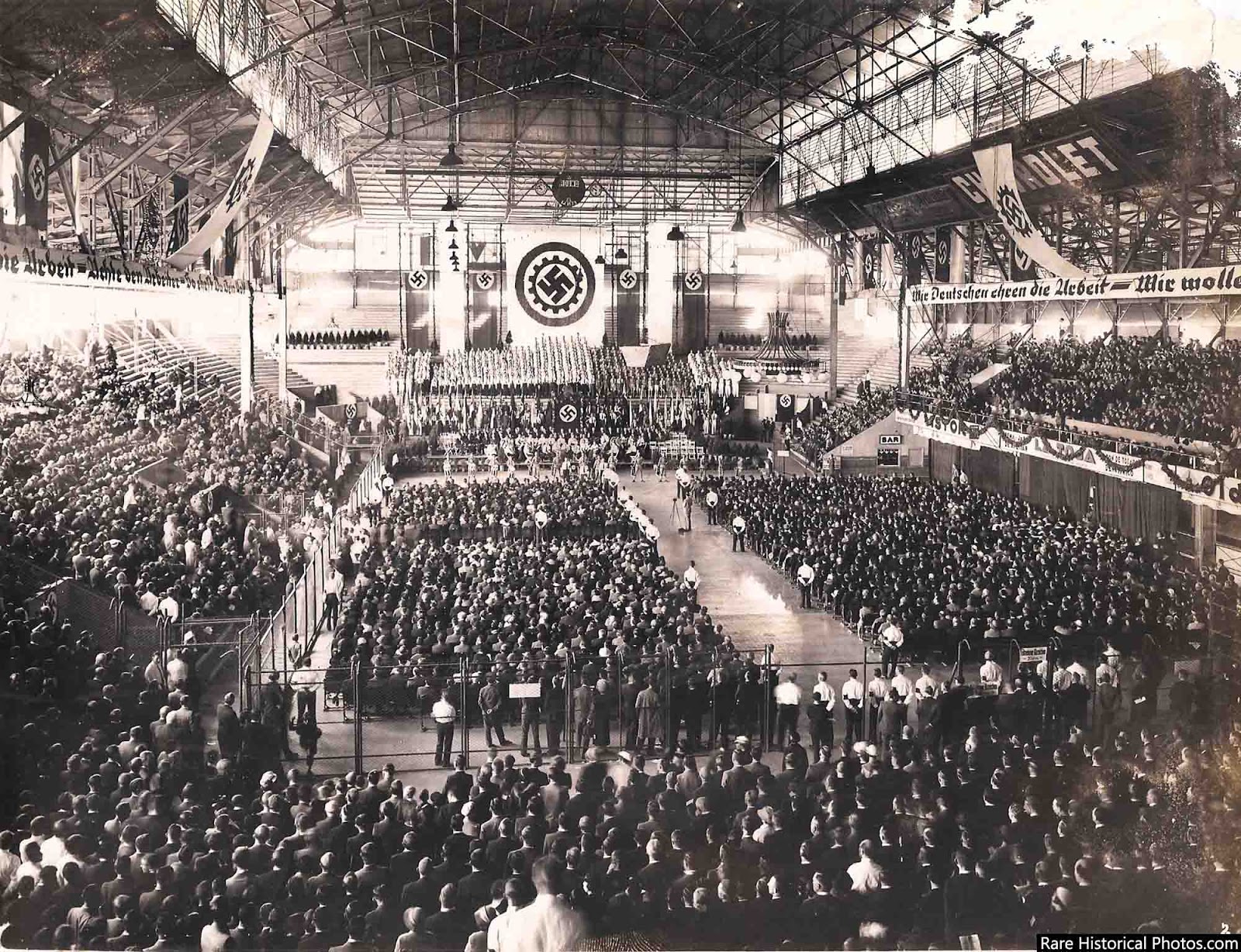
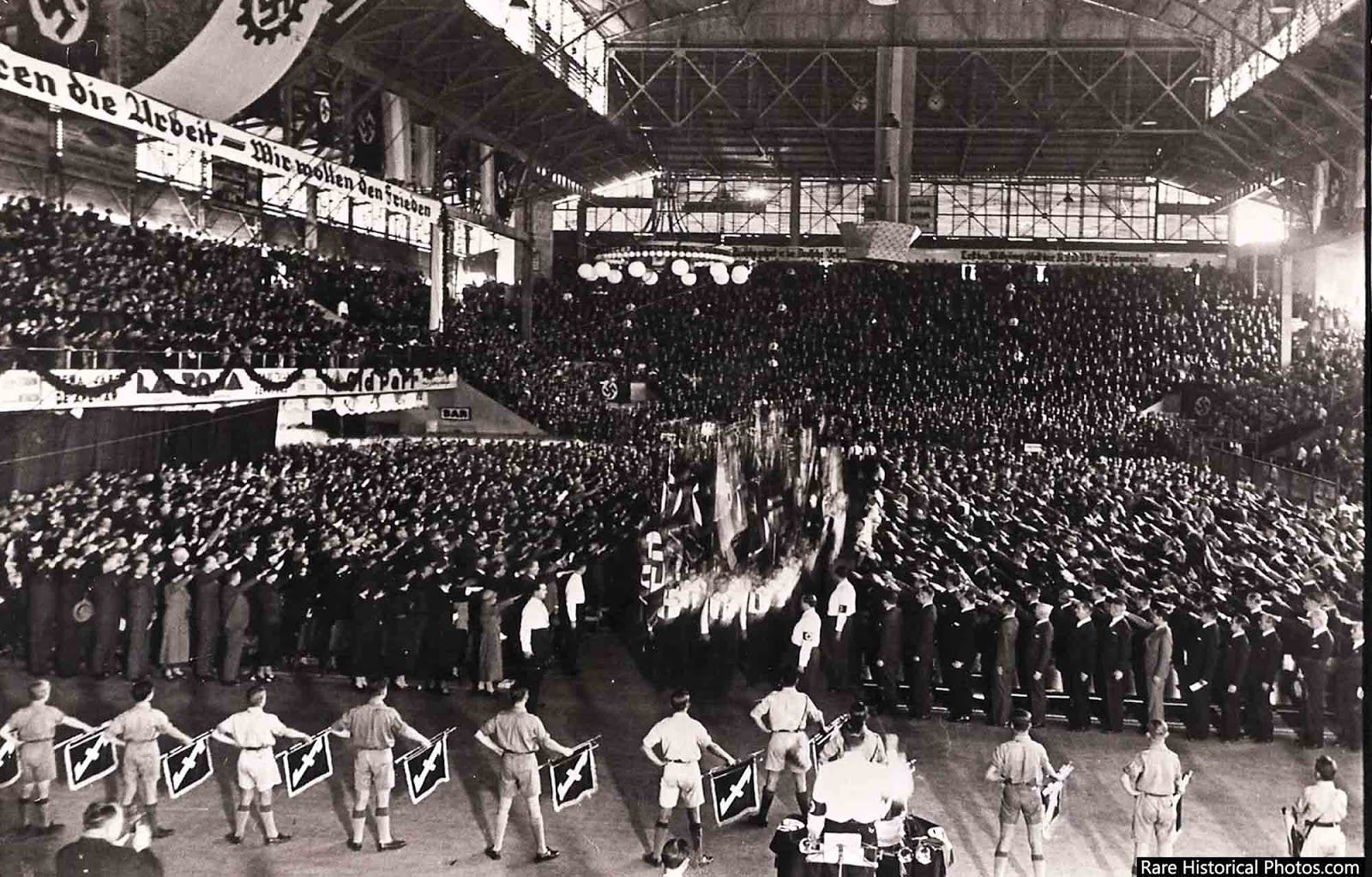

Beautiful photos. A proud reminder of what once was.
Me gustaLe gusta a 3 personas
Yes… We Argentines are a nostalgic bunch, as a whole.
I was stammered with the first photo… Hitler knew what he was doing with the swastika. It’s a powerful symbol indeed.
And it was popular BEFORE Hitler used it as a symbol for his party flag… I have seen old books covers that feature it. I think even Kipling used swastikas on his book covers as well, or, at least, someone put them on the covers.
Me gustaLe gusta a 2 personas
It’s a 5,000 yr old symbol of health and prosperity. It can be found all over the world.
Good nite.
Me gustaLe gusta a 2 personas
Yes, it is… Even around here you can find swastikas on the wild… I have read somewhere that they were dated FAR before the Germans did came with that idea as well. Can’t remember source right now, maybe it was the Spanish Metapedia. Good night.
Me gustaLe gusta a 1 persona
Reblogueó esto en Remember The 14 Words .
Me gustaLe gusta a 1 persona
Beautiful, I hope to live to see this again.
Me gustaLe gusta a 1 persona
Me too… Well, I am a bit younger, so, if we get working around here, it might be possible.
But the zio demockratic system must fail one more time, and bigger than the 2001 crisis… Now lemmings aren’t willing yet to consider it.
You know how it is.
Me gustaLe gusta a 1 persona
Great pictures. Thanks, for the information.
Me gustaLe gusta a 2 personas
I love these pictures, so much that I decided to post them as well (again, thanks to Cartier who sent me a link with these).
There also were a lot of people who were sympathetic to Mussolini (since there were lots of Italians, specially in Buenos Aires).
I think I’ve reblogged a photo from Rudolf’s blog a while back in which the title is «Fascismo Argentino», you might want to check that one. It’s a single photo.
Me gustaLe gusta a 2 personas
Yes, I found it.
A lot of people were sympathetic to Mussolini and Hitler, because they were great statsmen who made the trains come on time. Argentina was not alone in having open arms to Germany and German immigrants.
Paraguay, Colombia, Brazil, Uruguay, Mexico, Guatemala, Chile, Ecuador and Bolivia was friendly, too.
Me gustaLe gusta a 2 personas
Yes. Practically, half of South America, and some more countries as well… We had our first, brief stint of Fascism with Uriburu (that was on the 30’s, way before Perón was on the political scene)… But Uriburu was ill, and he had to resign on 1932, if I am not mistaken… He whooped the Freemasons’ collective asses, who, until then, had basically free reign over the country. Sadly, it didn’t last long, due to his illness (I think he had cancer).
Perón, fifteen years later, would apply a lot of the social measures that both Hitler and Mussolini applied in their countries… That made him inmensely popular as well, and with good reason. Sadly, Peronism as a force is dead, I mean, the party may still exist and govern (in some provinces), but spiritually, is dying… The same Peronists killed it. Too much corruption, and too little done for the people, while getting obscenely rich is what killed it… Menem departed radically of Peronist precepts on the early nineties, starting with the process of the party’s death.
Now we are heading into neoliberalism 2.0, which is far worse… And we having people (the middle class, above all) cackling with joy at Peronism’s death… Idiots, Peronists cared for them, now they will get screwed with Macri (they are getting screwed already, the faggots).
Mind you, I don’t like the actual state of Peronism either, and I believe that it died on the 70’s with Perón himself. The party itself is too corrupt to even care about it. Obviously, I don’t vote either.
Me gustaLe gusta a 4 personas
Sounds like what happens most other places, very sad!
Me gustaLe gusta a 1 persona
Yes, it is…
Me gustaLe gusta a 1 persona
you’re disgusting
Me gustaMe gusta
Well, thanks, pal. Just peruse the links to your right, then watch your jaw drop when you realize how deep the scam runs. Trust me, been there, done that. I recommend you this one…
https://holocaustdeprogrammingcourse.com
Me gustaLe gusta a 3 personas
how could you like someone who murdered millions and millions of people, you monster
Me gustaMe gusta
I dunno. Except that he didn’t…
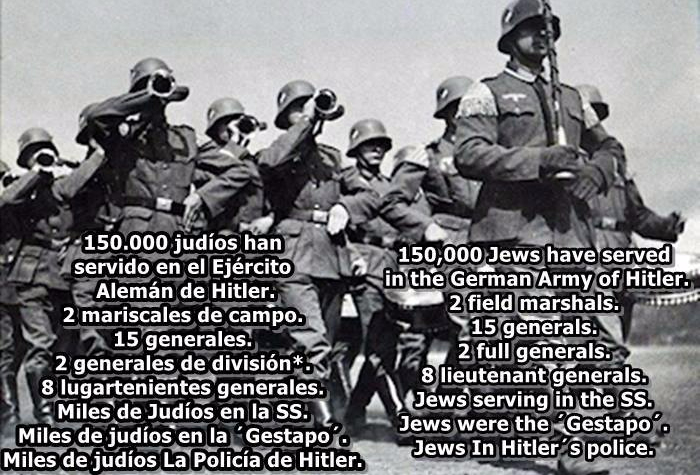
Trust me, I was like you once. Then I realized how deep these lies run. All of what do you think you know is a lie… Did you know that the Germans paid money to the inmates (the Jews) on the camps? Search for «Lagergeld», or look here
https://www.wintersonnenwende.com/scriptorium/english/archives/articles/ccmoney.html
Why they would pay them money? Why the gas chambers disguised as showers? Why not just kill them with bullets? Why the crematoria? Why, why, why? Think!
Do you know how long it takes to burn a single body in a crematoria? Just do the math, they would have been burning bodies till the 80’s… And we both know that this war ended in 1945.
Tell me how it turns out.
Me gustaLe gusta a 2 personas
Letter of the Ministry of the high clergy and BBC English propaganda.
This is a letter to the BBC and the senior members of the British clergy from 29 of
February 1944, the British Ministry of information. (I.e., propaganda)
Establishes unequivocally as follows:
We all know about the crimes committed by the Bolsheviks in the past 24
years in Russia and Eastern Europe. It is inevitable that they will do the same in
Central Europe. WE ARE GOING TO COVER THEIR CRIMES TO LIE ON THE
GERMANS. The public is not so stupid as it was, our lies
THEY WILL BE BETTER. You (BBC and the Church) should disseminate these lies,
convincingly!
«Lord,
I have directed the Ministry to send you the following circular letter:
Is often the duty of the good citizens and pious Christians the
turn a blind eye on the peculiarities of partners with us.
But comes the time that such peculiarities, while refuse in public,
they should be considered when the situation demands action.
We know the methods of Government employed by the Bolshevik dictator in the
In Russia, for example, writing and speeches of the Prime Minister himself during the
twenty years. We know how the Red Army behaved in Poland in 1920
and in Finland, Estonia, Latvia, Galicia and Bessarabia recently.
We must, therefore, take into account the way in which the Red Army without a doubt is
It behaves when taking out Central Europe. If you do not take the
precautions, obviously inevitable horrors that might be, will issue a
undue pressure on public opinion in this country.
We can not reform the Bolsheviks, but we can do our best
effort to save them – and ourselves – from the consequences of their
acts. The revelations of the last quarter-century represent mere negations little
convincing. The only alternative to denial is to distract public attention from
the whole issue.
Experience has shown that the best distraction is atrocity propaganda
directed against the enemy. Unfortunately, the public is not as sensitive as
in the days of the «factory of corpses», and the «mutilated Belgian babies», and the
«Crucificciones of Canadians.»
Your cooperation is therefore sincerely requested to divert attention
the actions of the Red Army, for his unconditional support of several public
charges against the Germans and Japanese who have been and will be placed in
circulation by the Ministry.
Its expression in the belief as already mentioned, can persuade others.
I am, Sir, your obedient servant,
(Signed) H. HEWET, SUB SECRETARY.
The Ministry cannot enter into correspondence of any kind with respect to this
communication, which should only be disclosed to responsible persons.
This letter (translated here) was sent to the BBC and superior on 29 February 1944 British clergy members, the British Ministry of information. (i.e., propaganda)
This is a direct admission of the British Government’s propaganda of outrage directed against the enemy.
This letter is reproduced in a book of 1958 entitled: Allied Wartime Diplomacy: A Pattern in Poland (Allied diplomacy in times of war: A model in Poland), by Edward J. Rozek, the image is a screenshot of the first edition. Pages 209/210.
COMMENTS:
«Factory of corpses», «mutilated Belgian babies», and the «Canadian Crucificciones»
It is an admission that he also lied about the Germans in the first war
World and millions of people died because of these lies without.
Me gustaLe gusta a 3 personas
Chlling, and true.
That’s another thing in which they lied, too. The supposed German atrocities on the First World War.
And do not forget the Katyn massacre, in Poland, made by the Bolshevists as well.
And the rapes of German women by the Red Army, and that wily jew Ilya Ehrenburg, who told the soldiers of the Red Army to rape German women, that they were their lawful booty.
We can go on and on, right, Signa?
Si que podemos. Podemos estar hablando de esto hasta cansarnos… Me pregunto si volverá al menos para insultarme de nuevo. Prefiero que lea los links y se desasne, por que nos han mentido MUY fuerte con esto.
Me gustaLe gusta a 3 personas
Just look at this…
http://www.biblebelievers.org.au/wasthere.htm
Take a good look there. You are being lied to death. All of us are, in fact.
Me gustaLe gusta a 2 personas
I hope your doubting thomas is checking out the links.
Me gustaLe gusta a 2 personas
Yes. Me too. He hasn’t replied not even to insult me again, so I think he just farted and fled.
He might be even a newbie to WP blogs. I checked his and it was pretty much newish. Only a short entry, and the theme wasn’t that much modified at all… I wonder if he knows that by checking the bell, you can see replies made to you.
Me gustaLe gusta a 2 personas
Well, maybe he’s actually looking at the links. Give him a few days. I check it out, too. I like drums myself, so I hope he posts some videos.
Me gustaLe gusta a 2 personas
I hope so… Well, you also remind me that most people can’t read as fast as I do, so I was expecting him to return pretty fast then.
It was last night, pretty late. I was eating dinner and he commented so fast that I had three comments to moderate. You see only two because his third comment was literally «np», so I just deleted it. Replying took me a bit more, I just searched those links (Signa’s image was pretty handy as well, it was a godsend) and replied.
Me gustaLe gusta a 2 personas
You can only do so much. We had to be convinced, too. When in my 20s, I was engaged to an intelligence agent and we were discussing the jews. In my ignorance I defended them. He then said: «They have been thrown out of every country they entered for the past 3000 years. What are they doing wrong?» That set me on the trail.
Me gustaLe gusta a 2 personas
Yes. And I was convinced rather accidentally at first… I found a link that spoke about jewish involvement on feminism (I think) and I clicked it. It took me to a Spanish site that dealt with the matter VERY completely, with lots of links, images and videos. I think this site is now defunct but it was very good… Then, I checked the Der Stürmer site… Geez, I knew that I was onto something when I saw the swastikas! I checked the links there, and I discovered lots of things that until then, didn’t make much sense to me. When I read some of Hitler’s speeches for the first time I was like: «WTF?! This guy was right!! He died seventy years ago but it sounds as if he just said it today!!» And then, I would never look at things the same again…
Me gustaLe gusta a 2 personas
There’s a book you’d like, Mein Side Of The Story, compiled with commentary by Mike King. I got it off Amazon. It’s all of Hitler’s key WW II speeches.
Me gustaLe gusta a 2 personas
I see. I have to check it out, then.
Me gustaMe gusta
https://www.amazon.com/s/ref=nb_sb_noss_2?url=search-alias%3Dstripbooks&field-keywords=Mein+side+of+the+story
Hurry up before the fuckers ban it.
Me gustaLe gusta a 1 persona
You are right. I was wondering if it was banned, but heck, if you still don’t tell me that, is because it’s not.
Me gustaLe gusta a 1 persona
88 customer reviews… We are up to something here, right? 😉
Me gustaLe gusta a 1 persona
One asshole called it propaganda. Hahahahaha!
Me gustaLe gusta a 1 persona
The one star reviews are funny as fuck!! «BAAAAAAAAWW hitler wuz baaaaad how u can defend him?» «Outrageous!»
Me gustaLe gusta a 1 persona
It only proves he didn’t understand or research what he read. Probly thought doing so would be a betrayal of the fucking jews.
Me gustaLe gusta a 1 persona
That would be outrageous for the jews! The poor self-styled chosen ones would be betrayed and left alone! Although they are masters at betrayal and backstabbing to boot!!
Me gustaLe gusta a 1 persona
How the fuck can they even stand each other?
Me gustaLe gusta a 2 personas
Geez!! Those fuckers are ugly!!
And those aren’t the ugliest jews out there, not!!
They stand each other by being reminded that they have to screw us over and over, so they stick. It’s an us vs them mentality, in fact.
Me gustaLe gusta a 1 persona
Good news, Cartier! I have permission to translate that Spanish entry you wished me to translate, about sports. Will get into that soon…
Me gustaLe gusta a 1 persona
Crap! Incogman is gone. He really raked jews over the coals.
Me gustaLe gusta a 1 persona
Fuck! I think I’ve checked his stuff once or twice, but it’s sad to hear that nonetheless.
Me gustaMe gusta
I used to go there all the time. Got into some pretty hot discussions in comments.
Me gustaLe gusta a 1 persona
Yay! Go for it!
Me gustaLe gusta a 1 persona
Going to run an errand right now, but do not despair, I began to do it and it’s not so long, so I will probably post it either late on the night (prolly after 22:00 Argentinian time) or early tomorrow. But it won’t take me more than a day to do it anyway.
Me gustaLe gusta a 1 persona
I shall die if you don’t.
Me gustaLe gusta a 1 persona
Hahahahahahahaha! Don’t die on me!!
Me gustaLe gusta a 1 persona
Well, at last…
Check it here:
https://thegasmaskblog.wordpress.com/2017/09/15/philosophizing-with-the-hammer-sports/
Me gustaLe gusta a 1 persona